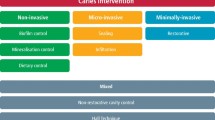Abstract
Data sources PubMed database. A manual screening among the references of selected articles.
Study selection Original articles, published in English relating to in vivo techniques (concepts /tools) to activity assessment of coronal carious lesions (AACCL).
Data extraction and synthesis Two reviewers independently and in duplicate screened the studies. A spreadsheet was used for data extraction and management. Results were described qualitatively.
Results Twenty-five articles were included in the review.
Conclusions Definition and harmonisation of standards for activity assessment-related concepts/tools is needed. Along with the above, further investigations are needed for in vivo validation of newly developed tools.
Similar content being viewed by others
A commentary on
Drancourt N, Roger-Lerol V, Martignon S, Jablonski-Momeni A, Pitts N, Doméjean S.
Carious lesion activity assessment in clinical practice: a systematic review. Clin Oral Investig 2019; 23: 1513-1524.

GRADE rating
Commentary
Understanding the dynamic nature of the carious process has impacted greatly on our management of caries in modern dentistry.1 The balance between demineralisation and remineralisation is key, with the aim of shifting the balance in the direction of remineralisation and 'healing'. If the demineralisation process progresses then the lesion is deemed to be active and from a diagnostic perspective it is paramount that consideration is given to activity state and potential. This way appropriate disease management strategies can be implemented in order to avoid cavity preparation. The question for this article addresses the assessment of carious lesion activity in clinical practice. The authors identify the need for clinicians to have tools to use in routine practice in order to make effective decisions.
The search strategy was comprehensive, the systematic review included English papers only. The authors only included techniques (concepts/tools) related to in vivo activity assessment of coronal caries lesions (AACCL) in clinical settings. Benchwork and prototypes were excluded. A total of 25 articles (published from 1962-2018) were included in the review. Due to the heterogeneity of the validation protocols/outcomes no meta-analysis was undertaken. Characteristics were described qualitatively.
Four groups of techniques for AACCL were identified:
Systems based on a combination of visual and tactile criteria
Devices based on pH assessment
Devices based on fluorescence
Devices based on bioluminescence.
Different tooth types (primary/permanent/mixed) and surfaces were studied. Validation criteria included:
Sensitivity
Specificity
Area under the receiver operating characteristics curve
Positive predictive value
Negative predictive value
Intra-examiner reproducibility
Inter-examiner reproducibility
Relative risk of lesion progression.
The authors state that AACCL should demonstrate good intrinsic and extrinsic validity and thus the above array of validation criteria. The issue of false positive/negative results and true positive/negative results were discussed along with reproducibility and lesion progression. None of the studies evaluated the full set of the above criteria.
The authors highlight the fact that, in various clinical settings and health systems, dental practitioners would perform a cavity preparation and place a restoration for a lesion that could have benefited from non-invasive treatment strategies.2 In order to improve the application of non-invasive strategies in clinical practice, easy to use devices/tools that give simple guidance to clinicians with regard to disease activity state could be useful. The authors recognise that conclusions to such activity assessment can be considered as surrogate measures that do not directly correlate with clinically relevant outcomes, but nevertheless give pertinent information. From the perspective of ensuring optimised health outcomes and cost-effective care, the development and use of validated techniques of AACCL should be encouraged. The authors suggest two recommendations for the scientific community for AACCL; the first is to harmonise standards for AACCL-related concepts/tools, the second to encourage in vivo AACCL devices based on fluorescence and bioluminescence in both primary and permanent teeth.
References
Featherstone J D, Doméjean S. Minimal intervention dentistry: part 1. From 'compulsive' restorative dentistry to rational therapeutic strategies. Br Dent J 2012; 213: 441-444.
Innes N P T, Schwendicke F. Restorative thresholds for carious lesions: systematic review and meta-analysis. J Dent Res 2017; 96: 501-508.
Author information
Authors and Affiliations
Corresponding author
Rights and permissions
About this article
Cite this article
Richards, W. Carious lesion activity assessment in clinical practice. Evid Based Dent 20, 39 (2019). https://doi.org/10.1038/s41432-019-0033-6
Published:
Issue Date:
DOI: https://doi.org/10.1038/s41432-019-0033-6
This article is cited by
-
Validity of Soprolife camera and Calcivis device in caries lesion activity assessment
British Dental Journal (2020)



